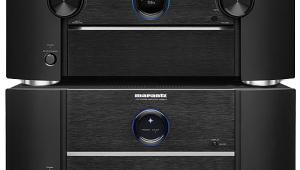Outstanding,the right combo is the key
Separates: Bring On the Heavy Artillery Page 2
Speakers with nominal impedances of 6 ohms or less present a more challenging load than 8-ohm speakers. They also require more current. Be warned, too, that a loudspeaker’s impedance varies continuously with the signal. It’s a moving target, so nominal impedance may not tell the whole story. Exercise common sense and ask an A/V specialty retailer or custom installer for suggestions on speaker/amp mating.
THX-certified amps have enough power to drive THX-certified speakers to at least the reference level (105 decibels peak) in rooms of specified sizes (up to 3,000 cubic feet for THX Ultra2 Plus, up to 2,000 cubic feet for THX Select2 Plus).
Power amps connect to processors through line-level analog connections, either XLR/balanced or RCA/unbalanced. XLR is more suitable for long runs as it provides added immunity to induced noise and hum. Note that if you want to use an A/V receiver as a dedicated surround processor and mate it with a separate amplifier, it will need multichannel analog preamp outputs. Only better models typically provide these connections.

Surround Processors, HDMI, and Lossless Surround
Surround processors do much of what an A/V receiver does, including surround
processing, preamplification, and A/V switching. But they don’t do power
amplification.
Paradoxically, standalone surround processors tend to lag behind AVRs in terms of features, despite their high-end brand identities. The companies that produce them are often smaller and less agile at getting new features into the product pipeline. To avoid buying an obsolete product, you must be skeptical and do your homework. Don’t assume that a high price tag or prestigious brand automatically means you’re getting the latest and greatest features, though for many enthusiasts, the perceived gain in audio performance is worth the sacrifice.
HDMI is one area in which many surround processors have just recently caught up to AVRs (so beware of older products still in the pipeline). Those with HDMI 1.4a provide 3D compatibility and other benefits of the latest HDMI version. A few may still go no further than HDMI 1.3, although even that allows onboard decoding for the latest lossless and other surround codecs, namely Dolby TrueHD and DTS-HD Master Audio. Most offer high-resolution PCM processing over HDMI as well. Many can convert analog video signals to digital and output them over HDMI, which increases switching convenience and allows a single cable connection to the display regardless of the multiplicity of connected sources. Some have advanced video processing.
High-resolution PCM can be helpful because older Blu-ray players convert Dolby TrueHD and other newer surround codecs to this uncompressed digital audio format for output through HDMI. SACD and DVD-Audio players can also convert to high-resolution PCM. The result is still a high-quality signal. In addition, converting to PCM in a Blu-ray player and sending that signal type to the surround processor allows you to enjoy secondary audio from picture-in-picture extras and other interactive features that are lost when sending raw bitstream data from a Dolby TrueHD or DTS-HD Master Audio soundtrack.
Dolby TrueHD and DTS-HD Master Audio are currently the highest-quality surround codecs. They are lossless formats, which means they restore the original digital audio signals bit for bit with no degradation, so you hear precisely what the filmmaker intended. They also store data more efficiently in terms of space and require more modest data rates than uncompressed PCM.
In addition, there are two improved lossy codecs, Dolby Digital Plus and DTS-HD High Resolution Audio. They’re called lossy because they don’t completely reconstruct the original signal. Though of high quality, they are rarely used on discs but are finding acceptance in streaming media. It’s safe to assume that any surround processor will come equipped to decode Dolby Digital and DTS, the old-school lossy codecs used on DVD, as well as the Dolby Pro Logic II, IIx, or IIz listening modes. You can learn more about these in our article on A/V receivers.

Video Processing
At the very least, you’ll want your surround processor to convert all incoming sources to the HDMI output. This way, it can feed the display with just one HDMI cable. Some surround processors have advanced video processing solutions. Our surround processor (and AVR) Video Test Bench reports always include results for a number of video
processing tests. HQV, Faroudja, Qdeo, Anchor Bay, and Gennum are among the better-known purveyors of high-end video processing. Surround processors certified by the Imaging Science Foundation (ISF) allow video to be fine-tuned by a custom installer.
Trickle-Up Features From A/V Receivers
Here are some features that appear in most better AVRs today. Some can be relatively rare in surround processors, though it depends on the manufacturer. As is the case with nearly all AVRs, some surround processors include advanced automatic-setup and room EQ features. These sophisticated features use a microphone (usually included) and internally generated test signals. They take a lot of the mystery out of setup by determining the size of the speakers in the system and the frequencies at which a speaker’s bass should cross over to a subwoofer. They also match the levels of the speakers in the system and tailor the system’s in-room frequency response for better performance. While many manufacturers use their own proprietary auto-setup and room EQ systems, Audyssey remains the best-known licensed solution. It comes in four variations. In descending order of quality, they are: MultEQ XT32, MultEQ XT, MultEQ, and 2EQ. The higher up, the greater the filter resolution and (in theory) the better the final result will sound.
- Log in or register to post comments


















































